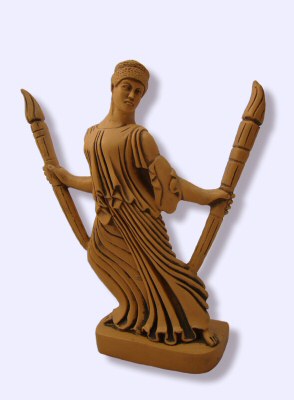Sisters
of the Burning Branch Goddess Gallery Presents...
Hecate

by Rachel Sarrano
Names:
Spellings of Her Name: Hecate/Hekate/Hecat/Hekat
Pronunciations: Heh-kay-tee, Heh-kit, Heh-cah-teh
Other
Magickal Names: Brimo, Divine Midwife, Chtonia, Dadouchos, Enodia,
Kleidouchos, Kourotophos, Phosphorus, Propolos, Propylaia, Soteria,
Triformis, Trioditis, Anassa eneroi, Soteira, Trivia
Symbols:
Symbols
that are sacred to her include torches, black dogs, serpents, swords,
lavender, golden sandals, keys, the color saffron, the color black, and
the color white.
Background Information:
In modern Wiccan
practices She is often pictured as part of the triple Goddess Diety,
with the Hecate aspect typically realized as Crone. She is
associated with Diana the Mother and Artemis the Virgin Huntress.
In
reality Hecate is an ancient Goddess. So old, that her lore
predates Greco-Roman cultures. She is included in the
Pantheon of the Titans, and in the Pantheon of Olympus. She is
feared and revered by Zeus. And in fact, was the only Titan to
retain her name and powers in the switchover to Roman times.
Some believe that she is also linked to Hekat the frog-headed fertility Goddess of ancient Egypt.
In
older images of the Goddess, she is singular in her authority, and is
often pictured as a comely matron, or young woman. She oversaw
much of human matters, and was even a protectress for pregnant women,
the childbed, and families. She is in truth, mistress of the
border between life and death. In later times, she is mostly
remembered and celebrated for her association with Death and the
Underworld. And thanks to dramatic works by writers such as
Euripides and Shakespeare, she is almost always considered to be a
Queen and Mother of all Witches, especially vengeful Witches dealing in
deadly arts. In some myths she is considered to be the mother of
the infamous Medea.
Rituals:
It is common to pay
respects to Hecate by leaving offerings at the crossroads on the night
of a dark or new moon. In voodoo practice, candy or coins are
thrown behind the back of the practitioner, as they walk through a
major crossroads. This was done to bring good luck, or let go of
woes from the previous lunar cycle. In ancient practices, crumbs
which fell to the floor of the home was only swept up on the dark
moon. And the rotting rubbish was left at the crossroads as an
offering to Hecate. Extending into the days of Christianity, people
left offerings of fresh food and drink at crossroads, which were eaten
by the poor and the vagrant.
A Ritual to End Excessive Bleeding:
This
is a good ritual for those of you that suffer from painful, heavy or
lengthy menstrual periods. It is also good for those of you that
have suffered a miscarriage, and need the bleeding to come to an end.
When
you start your bleeding, place a vase of fresh cut roses on your alter
space and let them soak in the energy there. Nightly, light a
black candle and ask the Goddess to ease your pain and fill your womb
with gentle healing and rejuvenation. Your blood is like a waning
moon. When the roses start to wilt and dry, take them from the
vase and anoint them with some of your blood. Wrap them up in a
paper sack and under the cover of night, take them to the crossroads in
a woody area. Remove the dead roses from your bag and place them
underneath growth away from the path. Thank the goddess for
bringing an easy period and ending the cycle. Walk away and don't
look back. Alternatively, if you live in an urban area, you could
dump the flowers, bag and all, into a garbage bin on a street
corner. Your bleeding should start to taper off almost
immediately.
Image: (from JBL statues----see attachments)
Bibliography:
Bibliotheca
Alexandrina, . Bearing Torches: A Devotional Anthology for Hekate.
Lexington, KY: Bibliotheca Alexandrina, 2009. Print.
d'Este, Sorita. Hekate Her Sacred Fire. London, England: Avalonia, 2010. Print.
d'Este & Rankine. Hekate Liminal Rites. London, England: Avalonia, 2009. Print.
Walker, Barbara. The Woman's Encyclopedia of Myths and
Secrets. New York: HarperCollins Publishers, Inc, 1983.
Copyright
2010
This
page is the intellectual and creative property of
Rachel Sarrano
Return

